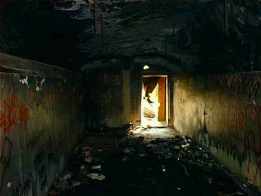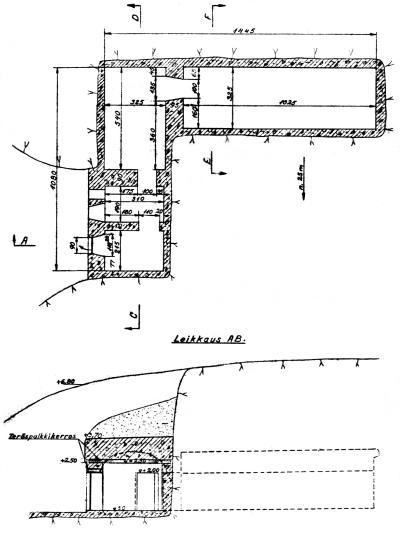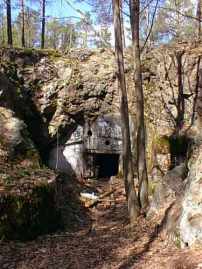Most important stores were in the tunnel-type shelters, which were blown in the solid rock. Cave has concrete walls and floor. Thickness of the rock over the cave were 5 - 10 meters. Inner roof was made using corrugated plate. Entrance is usually equipped with two walls and heavy steel doors.
Caves are usually straight or U-shaped or L-shaped. Area is 20 - 200 square meters. The biggest cave in the land front is object G10 (main telephone central) which area was 1400 square meters. Nowadays this cave has been enlarged more. There were over 90 tunnel-type stores in the land front. Part of them were unfinished.
Tunnel stores situated in background by the side of the roads and near the artillery batteries. After the civil war in May 1918 White army found tens of thousand projectiles, charges, rifle bullets, rockets etc. in the stores.
Concrete walls and floor. Corrugated plate inner roof has been removed, object XXIII:9. (1998)Caves used also as shelters and accommodation. After 1916 caves were made closer the front line. Entrances were directly in the fighting positions. For example there is a shaft with ladders from the bottom of the cave up to firing trench in object XI:2.
All land front caves listed before second world war for war industry. Detail from drawing 1937, object XXVIII:19 in Mäkkylä. (Military archive)After world war one most of the caves were used still. In the second world war some of the unfinished caves were fix up for war industry. Caves has used during the decades for example as a store for herrings or as a emergency hospitals for the time of crises. Some caves are abandoned and they are open. Some entrances have been filled with trash and some caves are full of water.
Entrance is filled with trash and soil, object XXI:6. (1998)
© 2000


